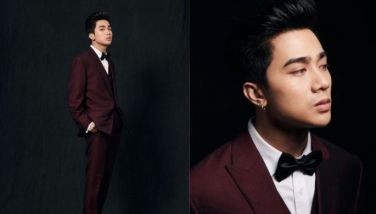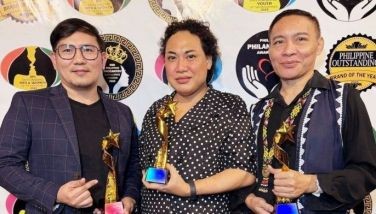It’s not easy being green
July 6, 2003 | 12:00am
 It may be unkind to say that the best acting in Ang Lee’s version of The Hulk comes from a computer-generated green monster. But it turns out director Lee actually acted out many of the scenes showing the anguished Hulkster – the CGI men then mapped out his movements on a computer and instructed the animated creature to follow suit. This may account for the fluid, almost ballet-like poses The Hulk adopts in the movie (that is, when he’s not bounding across the Mojave Desert in huge Crouching Tiger, Hidden Dragon-ish leaps).
It may be unkind to say that the best acting in Ang Lee’s version of The Hulk comes from a computer-generated green monster. But it turns out director Lee actually acted out many of the scenes showing the anguished Hulkster – the CGI men then mapped out his movements on a computer and instructed the animated creature to follow suit. This may account for the fluid, almost ballet-like poses The Hulk adopts in the movie (that is, when he’s not bounding across the Mojave Desert in huge Crouching Tiger, Hidden Dragon-ish leaps).
Certainly, the director deserves some credit for the impressive acting of The Hulk, who at least manages to generate audience sympathy. Too bad Eric Bana, the Australian actor who plays wimpy scientist Bruce Banner, can’t do the same. And too bad Jennifer Connelly is miscast as Banner’s gorgeous but largely passive girlfriend, Betty Ross; when she’s not selling her boyfriend down the river to her dad, a military general, she’s busy being rescued by the Big Green Guy. And too bad the older father figures – Sam Elliot as Ross’s father and Nick Nolte as David Banner, whose genetic experiments leave his son with a mutant gene – can’t quite breathe life into this reworking of the 1960’s Marvel comic book hero.
Most of us know The Hulk from the ‘70s TV show starring Bill Bixby and Lou Ferrigno (Ferrigno turns up in a walk-on here as a security guard at Banner’s lab). In that show, Bixby simply wandered the earth, getting mixed up with downtrodden characters and releasing his anger, eventually, on those who were doing the downtrodding.
Ang Lee’s The Hulk sticks closer to the comic book origins of the character, opening at a military base in the Mojave Desert, 1962. These desert sequences are powerful, especially since most comic readers at the time were worried about atomic testing taking place on arid landscapes very much like those shown (one dream sequence of Connelly’s shows a nuclear blast outside a diner – it’s pretty horrifying). With this back-story, Lee manages to inject a sense of history into the movie. We never really know why scientist David Banner keeps injecting himself with experimental drugs, but the "Los Alamos" background conjures up sci-fi movies from the ‘50s and ‘60s, movies that featured mutated tarantulas, ants and gila monsters.
In a sense, Ang Lee is a mutant of sorts, always willing to transform and adapt his film-making skills to the subject at hand. What other American director has gone from Asian comedy to Jane Austen to Rick Moody? He goes for a comic-book feel here, using split-screen shots again and again, even when there’s nothing much happening on the screen. The split screen is meant to suggest comic-book panels, of course, and, in at least some compositions, the multi-paneled shots are dynamic. But they’re also distracting, a device that wears out its welcome pretty fast. (For a more economic – and effective – use of the split-screen, check out Carrie White’s meltdown at the end of Brian DePalma’s Carrie.)
Lee was reportedly attracted to the Hulk story because of the character’s repressed rage. Of course, we’ve had a lot of movies on that very subject lately, most of them starring Adam Sandler (Anger Management, Punch-Drunk Love). Unfortunately, The Hulk doesn’t manage to elicit much sympathy for Bruce Banner, who’s inherited the mutant gene, since Bana’s acting is so thoroughly blah. He’s blander than Bill Pullman, if you imagine this.
The script of The Hulk reportedly went through plenty of rewrites (always a sure sign that no one can really nail down the story) and it shows. Most of the middle section is mired in murk – moody nighttime shots in laboratories and forests, enlivened only when The Hulk bursts out of the seams of bland Banner to rip apart a mutant poodle.
The movie only really comes to life when The Hulk is front and center, tossing around army tanks in a desert, or batting helicopters out of the sky. He takes to leaping across the landscape, which does conjure up Lee’s last film (Crouching Tiger) but is no less effective. In close-ups The Hulk’s face ripples with anguish, as if all the stale, bottled-up energy of the script and bland acting are suddenly being released in gamma doses of CGI. Make no mistake, these sequences save the movie from terminal lameness.
Another actor who vies for the Bottled-Up Anguish Award is Nolte, who manages to keep his overacting to a minimum through at least half the film. But then, during a final confrontation between father and son, Lee decides to let Nolte off his leash, and the seasoned method man with wild hair proceeds to spit and snarl and chew the scenery like a very bad doggie indeed. Or like a mutant poodle.
The ending? Well, let’s forget about the ending because it doesn’t make much sense. Let’s face it, The Hulk, artistic director or no, exists primarily as a vehicle to launch a Hollywood franchise. You can see all the Hulk advertising and product tie-ins decorating banners up and down EDSA. You know The Hulk will be back; Ang Lee is another story. Maybe by the sequel they can figure out a way to eliminate the human element altogether.
BrandSpace Articles
<
>
- Latest
- Trending
Trending
Latest
Trending
Latest
Recommended































